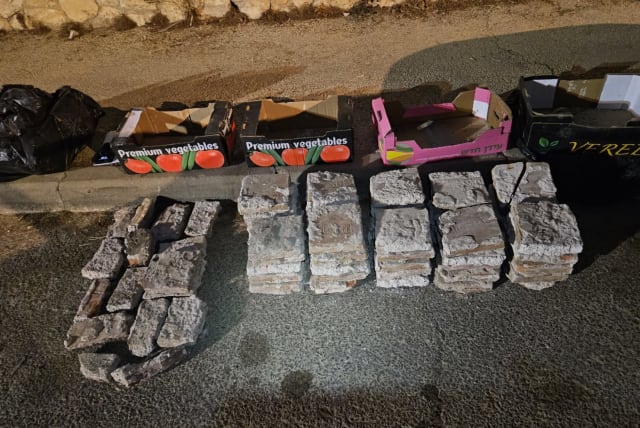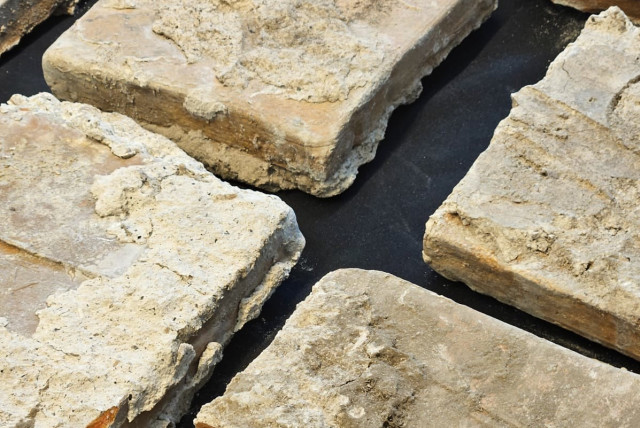Police seize stolen bricks imprinted with 10th Roman Legion symbols

‘They took a piece of history from us,’ bemoaned Israel Antiquities Authority
Dozens of ancient clay bricks with imprints of the 10th Roman Legion – which destroyed Jerusalem two millennia ago – were seized recently by Jerusalem detectives from a car on the road to Ramallah. The tiles had been removed from an antiquities site a short time ago.
The tiles were apparently used as part of the floor of a public building, possibly an ancient bathhouse. The police found several cartons in the car’s trunk full of archaeological artifacts and arrested the car’s owner, a resident of Jerusalem’s Beit Safafa neighborhood.
When police summoned inspectors from the Israel Antiquities Authority (IAI), they were amazed to find that the suspect had in his vehicle dozens of ancient Roman bricks, with fresh dirt traces indicating they had been removed recently from an antiquities site. The suspect was detained and interrogated, while the IAI is examining his claim that the bricks came from the Hebron area.
According to Amir Ganor, director of the IAI unit for the prevention of antiquities theft, “the bricks were apparently used as part of the floor of a public building – they may have belonged to an oven that stood in a bath house that was used by the Roman soldiers. The 10th Roman Legion arrived in Israel in 6 BCE and helped to fortify the control of the Roman kingdom in the land of Judah.
What role did the Roman legion play in ancient Israel?
Between the years 66 and 70 CE, the legion fought against the Jewish rebels in the Galilee, the Judean desert and the Jerusalem area, until the destruction of the Second Temple and the city of Jerusalem in 70 CE.
Later, the legion fighters defeated the last rebels in Masada near the Dead Sea in 73 CE, after a long siege. After the uprising, the legion soldiers settled in the greater Jerusalem area, where they established manufacturing facilities that made the bricks unique to the legion. On them, the symbols of the Legion LXF were stamped.
Later, the 10th Legion participated in the suppression of the Bar Kochba rebellion between the years 132 to135 CE, apparently suffering heavy losses. The legion continued to camp in Judea until the end of the third century CE, leaving behind public buildings and military camps.
“It hurts to see out of greed, people deface the floor of a 2,000-year-old public building and tear a piece of history,” bemoaned Ganor.
IAI director Eli Escosido commented that “discovering ancient bricks in the trunk of a car with fresh earth on them, signs of breakage and displacement is heartbreaking, as this means that another ancient site was looted and destroyed.
“If archaeologists had found the bricks at the site itself, we would have been able to add a lot of information for our archaeological research, as well as place another point on the history map of the country. Now we are left to try to find out, through investigative operations, from where the bricks were dismantled and looted.
“Our supervision system works day and night to protect the antiquities sites throughout the country from looting and destruction. We call on the general public to help us in the effort and report to the Antiquities Authority any signs in at archaeological sites of antiquities being stolen or antiquities being damaged.”
Jerusalem Post Store
`; document.getElementById("linkPremium").innerHTML = cont; var divWithLink = document.getElementById("premium-link"); if (divWithLink !== null && divWithLink !== 'undefined') { divWithLink.style.border = "solid 1px #cb0f3e"; divWithLink.style.textAlign = "center"; divWithLink.style.marginBottom = "15px"; divWithLink.style.marginTop = "15px"; divWithLink.style.width = "100%"; divWithLink.style.backgroundColor = "#122952"; divWithLink.style.color = "#ffffff"; divWithLink.style.lineHeight = "1.5"; } } (function (v, i) { });

